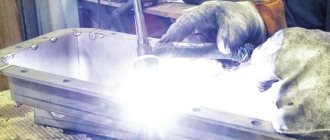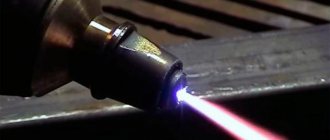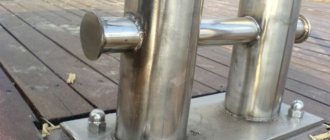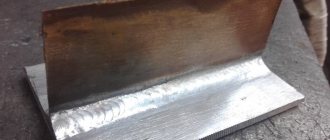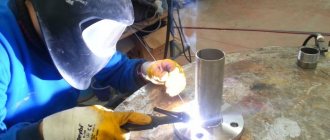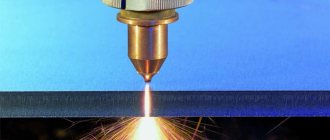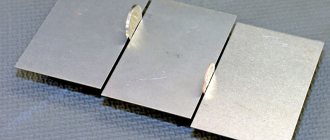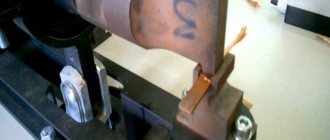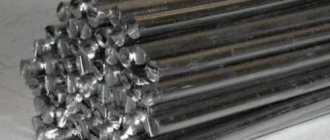Features of welding titanium and alloys based on it
Titanium and its alloys have a melting point from 1468 to 1830 °C. The metal has high heat resistance (up to 500 °C) and high corrosion resistance. These alloys can be hardened by adding chromium, manganese or vanadium as alloying additives. In this case, the plasticity of the material decreases.
However, when heated to 400 °C, the surface layers of the metal become chemically active and tend to react with available oxidizing agents, primarily oxygen and nitrogen from the air. In addition, when heated above 800 °C, alloys tend to increase grain size and porosity. Welding of titanium must take place in the absence of oxidizing gases.
Manual arc welding
The process uses a tungsten electrode with a direct current source connected. The area around the seam, the root of the seam and the adjacent thermally affected areas are protected. Insulation is provided by canopies, nozzles and thermally resistant porous materials into which gas is supplied. It is advisable to use linings made of copper or steel. If the pipe is being processed, the gas is released directly into the barrel. As for the optimal mode, for a 2 mm electrode the current strength can be about 90 A. This is the entry level for working with workpieces 4-5 mm thick. Specific values may also vary depending on how the titanium was alloyed. Titanium welding is performed with a short arc without oscillatory manipulation. The electrode tilts opposite to the direction of its movement - that is, at a forward angle. The operation cannot be completed abruptly. In order to prevent the formation of oxides, all protective devices remain in the same places even after the electrodes are disconnected.
Methods of welding titanium and its alloys
Taking into account the physical and chemical properties, titanium and titanium alloys are welded only by electric arc welding.
Basic methods of titanium welding:
- in a gas environment, with oxygen-free flux powder AN-11;
- electroslag for thick sheets, submerged arc AN-T2;
- contact in an atmosphere of protective gases.
Argon welding
During work, it is necessary to protect not only the working area, but also the reverse side of the connection from oxidizers. Therefore, titanium welding technology involves working in an isolated volume filled with an argon-based gas mixture. Additional protection is provided by using pads or butt welding parts.
Welding with steel workpieces
If the mass of the finished structure should not exceed a certain limit, titanium is welded with steel. This method is used in the construction of small and large structures.
But the differences between steels and titanium make it difficult to achieve high-strength joints. This is the main problem that shortens the life of structures.
This disadvantage is especially evident when titanium needs to be combined with stainless steel. Scientists are still exploring this area.
So far, there are only a few methods for welding titanium to steel:
- With the help of an explosion. To do this, another metal is laid between the steel and titanium blanks. For example, copper, silver or compounds of refractory metals;
- Diffusion welding. Best suited for combining titanium workpiece with stainless steel workpiece. The joint area will be less strong than the initial workpieces, but overall the seam will be reliable and tight;
- Wedge-press welding. This technique involves mechanical compression of workpieces under thermal influence. The seams are strong and less prone to corrosion;
- Spot welding and ultrasonic welding.
Preparatory operations
To obtain a strong and durable seam, it is necessary to prepare the surfaces to be welded. First of all, the oxide film should be removed. To do this, the parts are thoroughly cleaned and degreased on both sides at a distance of 20 cm from the seam line. Cleaning and degreasing should be carried out wearing protective gloves to prevent sweat and grease stains from coming off your hands.
Next, the surfaces are treated for 10 minutes with an etching composition - 35 parts of hydrochloric acid, 65 parts of water and 50 grams of sodium fluoride. The solution is heated to 60-70 °C.
Next comes the turn of mechanical processing - grinding with metal brushes and sandpaper No. 12 until burrs and cracks are completely removed. The filler wire should be treated similarly. Now you can proceed directly to welding titanium and its alloys.
Manual arc welding
The process uses a tungsten electrode with a direct current source connected. The area around the seam, the root of the seam and the adjacent thermally affected areas are protected. Insulation is provided by canopies, nozzles and thermally resistant porous materials into which gas is supplied. It is advisable to use linings made of copper or steel. If the pipe is being processed, the gas is released directly into the barrel. As for the optimal mode, for a 2 mm electrode the current strength can be about 90 A. This is the entry level for working with workpieces 4-5 mm thick. Specific values may also vary depending on how the titanium was alloyed. Titanium welding is performed with a short arc without oscillatory manipulation. The electrode tilts opposite to the direction of its movement - that is, at a forward angle. The operation cannot be completed abruptly. In order to prevent the formation of oxides, all protective devices remain in the same places even after the electrodes are disconnected.
Welding technology and modes
Manual welding of titanium and its alloys is carried out using tungsten electrodes with direct current of reverse polarity. During the work, equipment and additional devices are used to protect the working area and the heated area adjacent to the seam, and significant amounts of cooling suture material. These are special elongated nozzles with nozzles for supplying inert gases, visors, perforated backing plates with gas supply, etc. When connecting pipelines, the pipes are filled with protective gas from the inside.
Manual arc welding
Manual argon arc welding is most often used in the manufacture of unique products or in small-scale production, as well as when performing highly complex work for which it is not possible to program an automatic machine.
Manual arc welding
With a sheet thickness of up to 3 mm, the gap should be set from half a millimeter to one and a half, and welding can be done without adding filler wire. When using a 1.5 mm electrode and a 2 mm filler wire, the welding current for sheets 2 mm thick is chosen to be about 100 amperes, and for sheets 3-4 mm thick, the current is increased to 140 amperes.
The electrode is guided straight, without hesitation, and it should be inclined forward along the seam. If filler wire is used, it must be fed continuously and the electrode must be placed perpendicular to the workpiece.
After completing the seam and turning off the electric arc, it is necessary to supply protective gases for at least another one and a half to two minutes to allow the last section of the seam and the heat-affected zone to cool to 400 ° C. This protection prevents the formation of oxides. An oxidized seam is easily distinguishable by color:
- high-quality seam - yellow (straw);
- oxidized - gray-black, with a transition to blue.
Automatic welding
Automatic welding is carried out using tungsten electrodes using direct current.
If an infusible electrode is used, it is recommended to use straight polarity. The recommended diameter of the burner nozzles supplying shielding gas should be within 12-15 mm.
Ignition and extinguishing of the arc are performed not on the part itself, but on strips located near the beginning of the seam. This is due to the fact that at the beginning and end of the arc, during transient processes, voltage surges are possible, which can cause melting of the main part.
Titanium argon arc welding modes
When welding titanium with argon, they work with metal with a thickness of 0.8 to 3 millimeters.
Welding parameters depend on the sheet thickness:
- Electrode diameter 1 -3 mm;
- voltage 80-130 volts;
- current 45-220 A;
- electrode guiding speed is 18-22 meters per hour;
- gas consumption in the burner is 6-12 liters per minute;
- flow rate in the backing plate is 3-4 liters per minute.
Titanium submerged arc welding modes
With this method, the weld line is sprinkled with a thick layer of flux powder. A cloud of inert gases is formed as the flux powder burns in the flame of an electric arc and covers both the weld pool and the heat-affected space.
Submerged arc welding diagram
The method allows you to work with thicker parts - up to 5 mm for butt and corner joints, and for overlap welding - only up to 3 mm. The current used is from 250 to 330 amperes, the operating voltage is 24-38 volts. This method provides increased welding speed - from 40 to 50 meters per hour (almost a meter per minute).
Electroslag welding of titanium alloys
This method is used less frequently, but allows one to achieve high efficiency when joining workpieces made of titanium alloys with the addition of aluminum and tin. The method is very energy-intensive; three-phase welding sources are used. Welding currents reach one and a half thousand amperes.
Plate electrodes with a cross section of 12×60 mm are used. They make it possible to obtain a high-quality seam, and the suture material is close in its basic mechanical parameters to the material of the parts.
For pressed titanium parts, welding is carried out using round 8 mm electrodes. At the same time, it is not possible to achieve the same high strength indicators as for plate ones.
Electroslag welding
When working with this method, it is not recommended to use fusible electrodes made of alloy alloys, due to excessive saturation of the pressed material with welding gases.
Titanium resistance welding
When resistance welding, electrodes are not used to ignite the arc; their purpose is only to supply electric current to the work area. The arc is ignited directly between small zones of parts brought together under the pressure of the electrodes. The method is used for welding relatively thin rolled sheets during the manufacture of vessels, bodies, etc.
Contact welding can be:
- butt;
- point;
- suture or roller;
- condenser
According to research, the best reflow rate when working with large workpieces should be 2-3 mm/s. An increase in speed causes a decrease in the strength characteristics of the seam, despite the argon protective atmosphere.
In preparation for welding work, the edges of the workpieces should be milled or cleaned with abrasive materials. It is also necessary to thoroughly degrease both the seam line and the heat-affected zone up to 20 cm. Since titanium has low thermal conductivity, it tends to overheat. Therefore, the settlement value is set 10-20% higher than for structural steels.
Titanium butt welding modes
Welding modes are determined, first of all, by the cross-sectional area of the workpieces being welded. The method allows you to weld parts with a cross-section from 150 to 10,000 mm2. However, other characteristics vary depending on the section:
- sedimentary pressure 2.9-9890 MN/m2;
- reach 25-200 mm;
- melting allowance 8-40 mm;
- draft allowance 3-15 mm;
- melting speed 6-2.5 mm/sec;
- operating current 1.5-50 A.
Titanium spot welding
This method allows you to obtain a leak-proof connection of sheet metal up to 4 mm thick. It is widely used for mechanism housings and protective casings, for assembling various support frames, etc. The electrode must be strong enough to withstand the high compressive force of the sheets. To weld long seams in order to increase productivity, several electrodes are used, located at the same pitch as the seam points.
Spot welding
Titanium spot welding modes are determined by the thickness of the rolled product:
- sheet thickness 0.8-2.5 mm;
- contact surface 4-8 mm;
- electrode pressure 1.9-6.8 kN;
- pulse duration 0.1-0.4 s;
- compression duration 0.1-0.4 s;
- pulse current 7-12 kA.
Seam roller welding of titanium
This method is used to create hermetically sealed welded joints. Electrodes are used in the form of power rollers, which roll along the seam line and compress the sheets of workpieces together. Powerful current pulses are periodically applied to them so that the oval-shaped fusion zones overlap each other by 10-15%. The chain of such welding points forms a continuous sealed seam. The method allows welding sheets with a thickness of 0.2 to 3 mm and is very popular in the manufacture of sealed containers of low pressure vessels, such as fuel tanks, bellows, etc.
Modes of capacitor butt welding of titanium pipes
The capacitor method is a subtype of seam welding and differs from it in that the energy of the electrical pulse is stored in a battery made up of powerful capacitors, and the control module is periodically supplied to the electrodes. Pipe blanks with a diameter of up to 23 mm and a wall thickness of up to 1.5 mm can be welded even without a protective atmosphere, since a powerful pulse burns out oxidizers in the welding zone.
The welding mode is also determined by the diameter of the pipe and the thickness of its wall. The capacitance of the capacitor bank ranges from 5,000 to 7,000 microfarads, the pulse voltage is from 800 to 2,100 volts, and the compression force is from 8 to 24 kN.
It is very important to maintain the distance the pipes leave the liners (from 1 to 1.8 mm), since if it is exceeded by more than 2.2 mm, the ends shift and incomplete weld penetration occurs.
Titanium soldering technology at home
- 30-01-2015
- 47
- 107
Titanium, according to its physical and mechanical characteristics, is the most important modern structural material. It is quite widely used in industry and everyday life, so in some cases it is soldered. Its weight is almost 2 times less when compared with carbon steels and a number of non-ferrous alloys. Its density indicator is equivalent to 4.5 g/cm3. Titanium is a very strong (minimum value σв is 300 MPa), ductile (δ is equivalent to the limit from 25 to 50%) metal; its corrosion resistance indicator in some aggressive environments exceeds this characteristic characteristic of corrosion-resistant steels.
Argon-arc welding of titanium.
Features of titanium soldering
There is an alpha coating on the surface of titanium, which suggests the presence of atmospheric gases. Before the soldering process, the mentioned layer should be removed using sandblasting, which can be replaced by etching in a mixture with a certain composition: 20-30 ml of h3NO3, 30-40 ml of HCl and 1 liter of water. The etching period should be limited to 5-10 minutes. whereas the temperature indicator should be equal to 20 ° C. After such treatment, an oxide deposit of insignificant thickness will still be present on the surface of the material, which will prevent the base from being wetted with solder. For this reason, at home, craftsmen try to solder the material using special fluxes, the composition of which is similar to that of fluxes designed for working with aluminum. However, you should be prepared for the fact that the joints obtained using such fluxes do not have significant strength and quality.
Scheme of laser soldering of riving plates.
As a rule, titanium and its alloys undergo soldering under vacuum or argon conditions, the latter must be freed from oxygen particles, water vapor and nitrogen. Only under ideal conditions, oxide and nitride deposits on the surface of the material are neutralized in the metal, which is true if the temperature during work exceeds 700° C. This requires working with titanium at temperatures ranging from 800 to 900° C, which guarantees rapid cleaning of the base of the material and intensive wetting of it with solders.
Soldering of titanium alloys at high temperatures is not carried out so often, which is especially true for furnace melting. This is explained by the fact that during prolonged heating, when the temperature exceeds 900° C, there is a tendency to increase grain and deteriorate plastic characteristics. Since the strength level of the main metal remains almost unchanged, in some cases the mating of titanium alloys by soldering is carried out even at 1000° C.
Hydrogen, which is present in titanium and reduces its ductility, is eliminated during the soldering process or during heating at 900 ° C. Therefore, work with titanium should be done in a space devoid of air, this is preferable to working in a neutral atmosphere.
Titanium, although it requires the provision of difficult conditions, is still meltable, while cast iron is a difficult-to-weld metal.
Increasing the welding temperature and subsequent cooling contribute to changes in the structure of the characteristics of cast iron in the melting and weld regions, which indicates that it is very difficult to obtain defect-free joints with the required level of properties.
https://moiinstrumenty.ru/youtu.be/wU8JshTLqDk
Soldering Features:
- the need to use special fluxes;
- the need for a vacuum;
- It is recommended to use silver as a solder base.
Return to contents
Wave soldering installation diagram.
Before soldering titanium at home, you need to choose the right solder, method and features of the work. It should be taken into account that titanium contributes to the formation of brittle intermetallic compounds in the solder seam with almost all elements that are in the solder. For this reason, as a rule, silver is preferred as a solder base, since it forms intermetallic compounds with titanium that are not so brittle compared to other metals.
It is very problematic to carry out high-quality soldering of cast iron yourself, which also applies to soldering titanium in a vacuum using non-added aluminum. This is explained by the fact that intermetallic phases appear in the weld, and the joint does not have any strength.
The thickness of the interlayer can be minimized if Ni-alloyed aluminum is used as the solder. This and some other elements, 1% each, affect the displacement of the intermetallic layer.
https://moiinstrumenty.ru/youtu.be/AgnuYc3kbHE
Soldering alloys of the described metal using tin-lead or other low-temperature solders is rarely used. In this case, before starting work, titanium must be coated with nickel using a chemical or galvanic method. But if you need to use cast iron in the soldering process, then it is preferable to entrust the matter to professionals.
moiinstrumenty.ru
Possible welding defects
One of the most common defects is increased weld porosity. It occurs due to the absorption of hydrogen bubbles entering the weld pool by the suture material. To avoid porosity, you should:
- thoroughly clean and degrease working surfaces;
- ensure sufficient protection of the weld pool and the area of cooling metal.
The formation of an oxide layer extending from the weld line to the solid metal of the workpiece is also common. This can be avoided by maintaining a protective gas cloud until the weld cools to a temperature of 400 °C.
Contact
The use of contact technology can be quite justified if you need welding of titanium pipes. Key Features:
- For contact welding, pipes with a diameter of 1-2.5 centimeters and a wall thickness of about 1 millimeter are suitable. Such pipes do not require protection with inert gases.
- The optimal charging voltage in this case is 900 volts (for 10 mm X 1 mm pipes) or 2000 volts (for 25 mm X 1.5 mm pipes).
- Before welding, it is necessary to etch the edges of the pipes.
Features of the technology
The main feature of argon metal welding is the high speed of the work, otherwise titanium overheats and becomes brittle. Therefore, the main requirements are: continuous supply of solder at a constant speed of 2-2.5 mm/s electrode. In this case, the experience and skill of the welder is important, whose movements must be accurate, without deviations of the electrode to the sides.
“Forward corner” welding technology, when the movement of the electrode starts from the bottom and goes up to the edges of the parts being connected along the thickness. After welding is completed, argon is supplied to the surface of the seam until it cools to 400°C, 1-2 minutes in time.
The approximate consumption of argon for a welding seam is 5-8 liters per minute, for blowing from the reverse side - 2 liters per minute.
